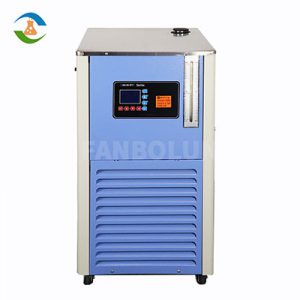Introduction To Diaphragm Vacuum Pump
This series of anti-corrosion diaphragm vacuum pump is a two-stage pump with gas as the medium. All parts in contact with the body are made of polyvinyl chloride (PTFE). Diaphragm vacuum pump has high corrosion resistance and an application range

Diaphragm Vacuum Pump Features:
Oil-free operation:
Diaphragm vacuum pumps do not require oil lubrication, which means they are not contaminated by oil.
Low noise and vibration:
Diaphragm vacuum pumps are designed for quiet operation and low vibration, making them suitable for use in laboratory environments.
Easy to maintain:
Diaphragm vacuum pumps are relatively easy to maintain, requiring periodic diaphragm replacement and pump cleaning.
Chemical Resistance:
Some diaphragm vacuum pumps are designed to be resistant to chemicals and solvents, making them suitable for use in harsh environments.
Compact design:
Diaphragm vacuum pumps are often compact in size, which makes them ideal for use in applications where space is limited.
High efficiency:
Diaphragm vacuum pumps have high efficiency and some models can achieve high vacuum with low power consumption.
Security function:
Some diaphragm vacuum pumps have safety features such as thermal overload protection, which help prevent damage to the pump if it overheats.

Diaphragm Vacuum Pump Application
Diaphragm vacuum pump is mainly used in chemical industry, environmental protection, water treatment, food, pharmaceutical, electronics, mining, spraying and other industries.
Chemical industry:
Acids and bases, solvents, suspended solids, etc.
Water treatment:
Sewage, chemicals, waste water, soft sediments, lime slurries.
Paint industry:
Paints, resins, solvents, colorants, etc.
Daily chemical industry:
Shampoo, lotion, emulsion, hand cream, body milk, detergent, surfactant, etc.
Ceramic industry:
Clay slurry, mud, porcelain slurry, lime slurry, etc.
Petrochemical industry:
Sludge, mud, crude oil, heavy oil, grease, etc.

Maintenance:
Content:
(1) Check the diaphragm vacuum pump pipeline and joints for looseness. Turn the diaphragm pump by hand to see if the diaphragm pump is flexible.
(2) Add bearing lubricating oil to the bearing body, observe that the oil level should be at the center line of the oil mark, and the lubricating oil should be replaced or replenished in time.
(3) Unscrew the water diversion screw plug of the diaphragm vacuum pump body, and pour water (or slurry).
(4) Try to control the flow rate and head of the diaphragm vacuum pump within the range indicated on the label to ensure that the diaphragm pump operates at a high efficiency point in order to obtain the greatest energy-saving effect.
(5) If abnormal sound is found in the diaphragm pump, stop immediately and check the cause.
(6) When the diaphragm pump is to be stopped, first close the gate valve and pressure gauge, and then stop the motor.
(7) Note that the lubricating oil should be replaced regularly.
(8) Frequently adjust the packing gland to ensure that the dripping in the stuffing chamber is normal (preferably dripping out).
(9) Regularly check the wear of the shaft sleeve, and replace it in time after the wear is large.
(10) When the diaphragm vacuum pump is used in the cold winter season, after parking, unscrew the drain plug at the lower part of the pump body to drain the medium.
(11) If the diaphragm pump is out of service for a long time, it is necessary to disassemble the pump completely, wipe off the water, apply grease to the rotating parts and joints and install them.

Parameter
| Model | KDDP-Q-25 |
| Traffic(M3/h) | 0~0.8 |
| lift(m) | 0~70 |
| Outlet pressure(kgf/cm2) | 6 |
| Suction(m) | 7 |
| Maximum allowable particle diameter (mm) | 2.5 |
| Maximum air supply pressure(kgf/cm2) | 2~8.5 |
| Maximum air consumption(m3/min) | 1.2 |
| Normal air consumption (m3/min) | 0.45 |
FAQ
Q: Diaphragm vacuum pump can start, but not work normally
A: Possible reasons:
- The power supply voltage is too low
- The motor is under thermal protection
- There is residual negative pressure in the pump body and cannot be started
- The rubber membrane of the pump body is stiff from the cold outdoor to the indoor
Approach:
- There is air leakage in the filter device or hose
- There is foreign matter on the pump core film
- The air inlet of the pump is blocked by liquid crystals
- The pressure gauge indicates incorrectly
Q: The diaphragm vacuum pump works normally, but the vacuum degree cannot reach the normal value
A: Possible reasons:
- Check whether the power supply voltage is 220V;
- Wait for the motor to cool down and start it later;
- Release the pressure of the pump;
- Separate the pump from the filter device, turn on the power switch of the pump body, and run it idle for one minute. After the pump heats up, it can work normally.
Approach:
- Check the filter device and rubber hose to eliminate air leakage points;
- Clean the pump core film;
- Use a needle-like object to clean the outside and the inside of the outlet;
- Replace the pressure gauge.





